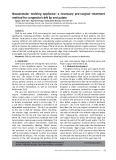
HUE JOURNAL OF MEDICINE AND PHARMACY ISSN 3030-4318; eISSN: 3030-4326 9
Hue Journal of Medicine and Pharmacy, Volume 14, No.6/2024
Nasoalveolar molding appliance: a necessary pre-surgical treatment
method for congenital cleft lip and palate
Nguyen Dinh Tien1, Ngo Nam Hung2, Hoang Minh Phuong1, Tran Tan Tai1*
(1) Odonto-Stomatology Faculty, Hue University of Medicine and Pharmacy, Hue University
(2) Department of Dentistry, Nghe An Obstetric and Pediatric Hospital
Summary
Cleft lip and palate (CLP) are among the most common congenital defects in the craniofacial region,
significantly impacting aesthetics, function, and the psychosocial well-being of both patients and their
families. Particularly in cases of wide clefts, the anatomical structures on either side of the cleft are often
severely deficient and deformed, complicating surgical procedures. Pre-surgical orthodontic treatment,
especially with the Nasoalveolar Molding (NAM) appliance, has gained increased attention recently due to its
ability to improve the position and shape of facial structures, facilitating optimal surgical outcomes. The goal
of pre-surgical NAM treatment is to reduce the width and enhance the symmetry of the structures on both
sides of the cleft, including the lip, nose, and alveolar ridge. Given its benefits, NAM treatment is increasingly
encouraged and emphasized for newborns with cleft lip and palate.
Keywords: Cleft lip and palate, Nasoalveolar Molding (NAM), pre-surgical orthodontics.
Corresponding Author: Tran Tan Tai. Email: tttai@huemed-univ.edu.vn
Received: 14/6/2024; Accepted: 14/11/2024; Published: 25/12/2024
DOI: 10.34071/jmp.2024.6.1
1. OVERVIEW
Cleft lip and palate are among the most common
defects in the craniofacial region. The prevalence
of this condition varies across countries worldwide,
influenced by socioeconomic status, environmental
factors, geography, and differences in genetics
and race. The causes of cleft lip and palate are
believed to be multifactorial and polygenic [1], with
various genetic variants, as well as environmental
factors such as smoking and alcohol [2-4] and the
use of certain medications, as well as nutritional
deficiencies [5, 6].
The care and treatment of craniofacial defects
require multidisciplinary collaboration. Among
these, surgery plays a crucial role in restoring the
facial structure to as normal a condition as possible.
As Brophy emphasized nearly a century ago: “It is
a rule that a reliable foundation is essential to all
dependable superstructures. The lip is no exception
to this rule in cleft lip” (Brophy, 1927). Therefore,
the alveolar ridge, premaxilla, and maxilla form a
foundation for the lips and nose that are situated
above [7]. These are deformed in patients with cleft
lip and palate, making surgery more challenging. This
necessitates pre-surgical intervention, especially
with the Nasoalveolar Molding (NAM) device,
which has been proven to significantly improve
the outcomes of the first repair in patients with
cleft lip and palate compared to other pre-surgical
orthodontic techniques. This includes reducing the
severity of the cleft, reshaping the position of the
lips, nose, and alveolar ridge to facilitate easier and
fewer surgical interventions [8].
1.1. Historical development
Throughout history, various pre-surgical devices
have been used with the goal of reducing the
complexity of cleft lip and palate (CLP) surgeries.
Franco developed a head cap as an external means
to reduce the gap. In 1686, Hoffman designed a head
cap that extended to the face via the cheeks and lips
to retract the premaxilla backward. In 1776, Chausier
designed a cheek compression bandage to treat
cleft lip as a treatment method for a large number
of patients “despite the continuous movement of
young children”. In 1790, PJ Desault invented a rather
complex compression fabric bandage that he applied
to prevent the protrusion of the premaxilla for 11
days before surgery to create a constant backward
pressure”… [9]. In the modern era, in 1950, McNeil
described the first pre-surgical orthodontic device
capable of stimulating tissue growth and reducing
the width of the cleft in the alveolar ridge and palate
[10]. Subsequently, physicians recommended a
pre-surgical device to adjust the alveolar ridge and
reduce the width of the cleft lip and palate. The first
was the Hotz appliance, a passive device consisting
of a simple base that helps guide the development
of the alveolar ridge’s shape without the need for
external force [11]. In 1976, Latam et al. described the
Latam device, which uses a pin placed in the palate
to stimulate the development of the premaxilla and
expand the posterior part of the upper jaw [12].





















